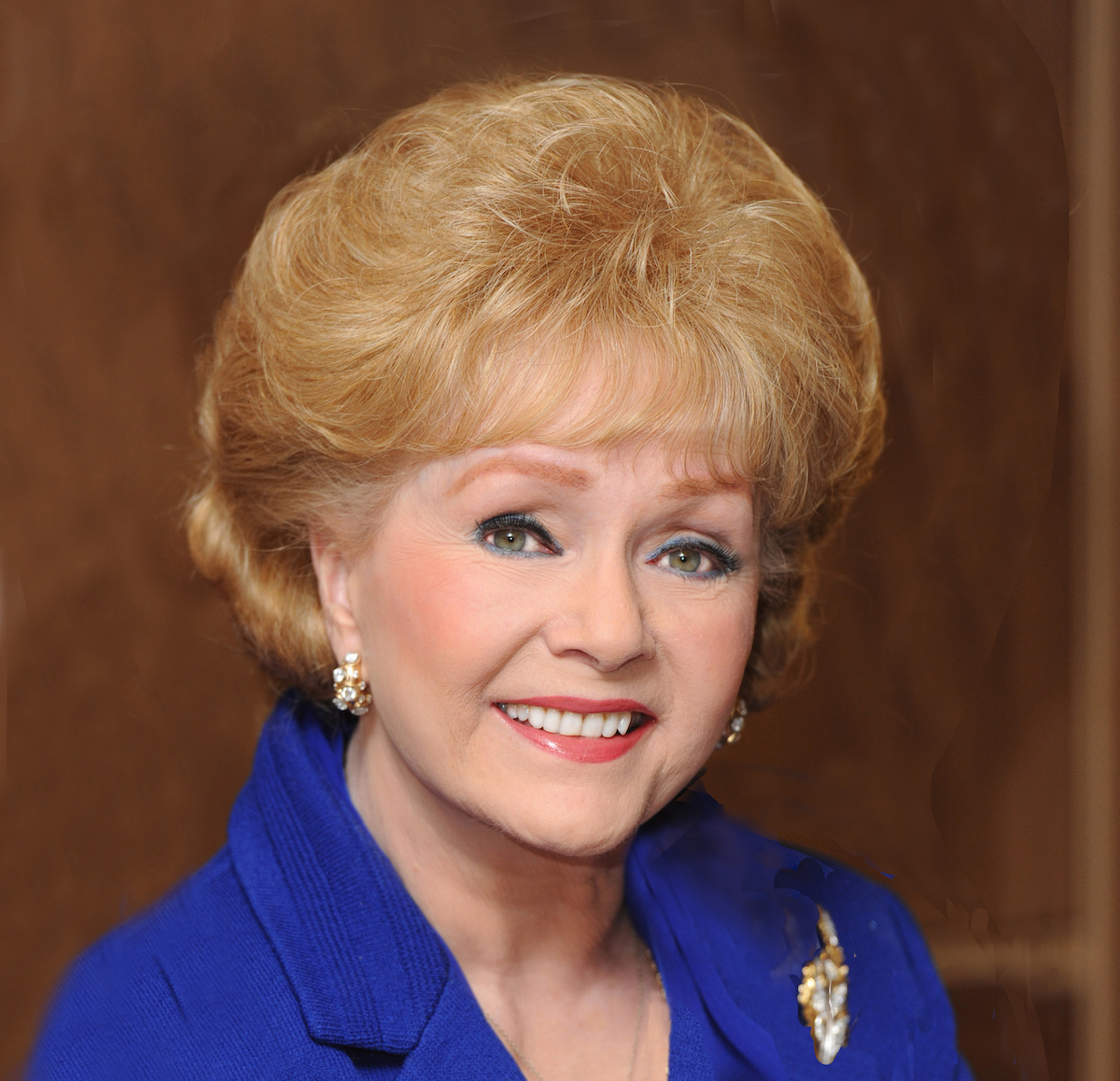One of the very last of the old-time Hollywood studio stars, the ever-smiling Debbie Reynolds always presented herself to the world like a cheerful dream that had been created by experts in her youth. No one believed in that dream quite as fervently as she did. Reynolds loved and believed in old Hollywood so much that she even tried to save some of its history when the studios started selling off their old costumes and props, buying as many of them as she could. Her dream of a museum for all of her treasured memorabilia never happened, unfortunately, because Hollywood does not value its past. There was a hurt sometimes behind her smile as she got older, and that loss of a museum for what she had saved was certainly part of that hurt.
In later years, Reynolds was usually wearing spangles or sequins and her hair was elaborately coiffed on top of her pretty little head as she sang and told her jokes in her continually touring nightclub act; there was something bird-like about her, semi-naughty and watchful and just a little bit sharp. She was born in El Paso, Texas, but raised mainly in Hollywood, where she won a beauty contest (she was crowned Miss Burbank in 1948 at age 16) and eventually signed to a contract at MGM. Reynolds played Helen Kane in “Three Little Words” (1950), signaling her cuteness to the camera while she lip-synched to Kanes’ boop-a-doop vocals, and then she delivered a hit novelty song with the equally cute Carleton Carpenter called “Aba Daba Honeymoon” in “Two Weeks with Love” (1950). It’s a tongue-twister thing, this song, and it’s no use resisting how adorable Reynolds and Carpenter are as they sing it with their heads sometimes pressed closely together.
The following year Reynolds was the lead in what many people consider the finest of all American musicals, “Singin’ in the Rain” (1952), opposite Gene Kelly and Donald O’Connor. It wasn’t easy. Reynolds detailed in her memoirs just what a hard taskmaster Kelly was in rehearsals on this movie, and Kelly himself later said, “I wasn’t very nice to Debbie. I’m surprised she still speaks to me.” Reynolds was a fast learner, but Kelly demanded far more of her dance-wise than she thought she could give, and the world-class result proved that she could smile brightly through anything. Just look at Kelly, Reynolds, and O’Connor singing and dancing their way through the number “Good Morning” and it is hard to think that life is meaningless when people can do things like that.
There was a vitality in Reynolds that sometimes seemed super-human, and off-screen she was an American success story and go-getter who knew the value of publicity. Her talent was real: take a look at some of the casually earthy dances she does with Bob Fosse in “Give a Girl a Break” (1953), which shows what a flexible performer she was. Reynolds could rise to any occasion when it came to dancing, and as a singer she had hit records in this period, none more popular than “Tammy,” which she sang for the rest of her life. The sound of Reynolds singing “Tammy” was lyrically used during a poetic montage in Terence Davies’s film on childhood, “The Long Day Closes” (1992), because the sweet sound of her voice summed up a whole point of view for his generation.
Reynolds was equal to any musical challenge, and she was also able to hold her own opposite Bette Davis in the kitchen sink drama “The Catered Affair” (1956). But she was most known during this time, of course, for the scandal of her husband Eddie Fisher leaving her for their mutual friend Elizabeth Taylor, an embarrassment that was milked for every possible publicity opportunity, story or angle for the rest of her life. Reynolds learned to joke about Fisher and Taylor, and she even re-friended Taylor as an older woman. There might have been genuine hurt there, but then again, Reynolds had pledged herself to a glamorous make-believe life both off-screen and on where the idea of “genuine” emotion could start to feel a little tricky.
Reynolds was nominated for an Oscar for “The Unsinkable Molly Brown” (1964), a star vehicle where she went from strenuous tomboy to lady of wealth in a manner probably not too far from the way that she had transformed herself as a girl from El Paso who learned her diction from MGM. She proved her comic skill in Vincente Minnelli’s “Goodbye Charlie” (1964), but by age 40 she was no longer wanted in movies and she turned to club work and the nostalgia circuit.
As her daughter Carrie Fisher became a star in her own right as Princess Leia in the “Star Wars” movies, Reynolds kept working and saw a version of herself played by Shirley MacLaine in a movie of her daughter’s book, “Postcards from the Edge” (1990). At the time, Reynolds commented that she wasn’t a good enough actress to play this part herself, and this shows both her show-biz objectivity and her peculiar relationship to the “reality” of her star persona. She got a leading role opposite Albert Brooks in “Mother” (1996) that displayed once again just how skillful she was with a laugh line. And her daughter even wrote her a vehicle called “These Old Broads” (2001) for television where she got to confront Elizabeth Taylor and mend fences for the cameras.
There had been rocky years with Fisher, but mother and daughter became extremely close over time, and this was documented in the movie “Bright Lights: Starring Carrie Fisher and Debbie Reynolds,” which premiered at the New York Film Festival and will play on HBO next year. Fisher’s unexpected death at age 60 dealt a blow to Reynolds that must have played a role in taking her own life right afterward, and that’s tragic if we look at it from a realistic point of view. But as Fisher herself often noted, both mother and daughter fought to keep reality at bay in their own very different ways.
Reynolds was a trouper, and pure show business. She ate and drank show business. She exuded show business from every pore. What was underneath? Probably a scared but determined girl from Texas who built up this other starry person who could smile through any misfortune. It’s very sad that Fisher and Reynolds should die in tandem like this, but at the same time it’s a fittingly dramatic ending to the story of their lives, and both of them were self-aware enough to have fully appreciated that. What a shame it is that they can’t both be here to see our reaction to this ending.












